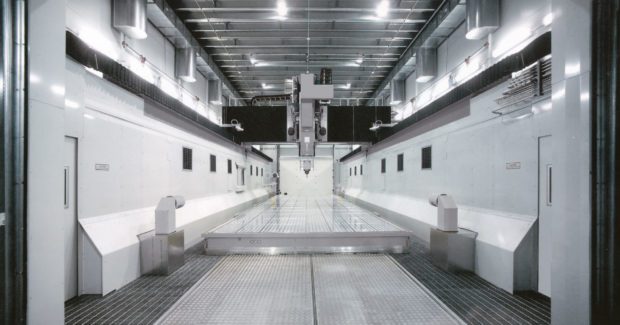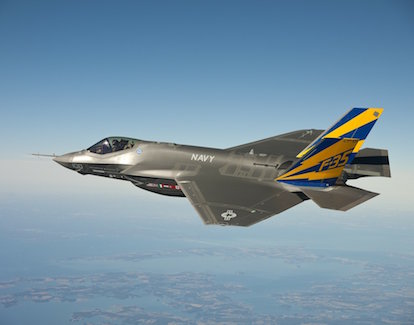F-35 Fighter Jet Blasts Off with Precision Components
As a joint strike fighter (JSF) partner, Starrag Group machines help manufacture the world’s most complex military aircraft. The Droop+Rein FOGS 6-axis machining center with 300 Nm spindle rough-machines steel and titanium components using a variety of heads and performs high-speed finishing of dies.
Posted: September 29, 2020
BY ELENA SCHMIDT-SCHMIEDEBACH
It takes a single pilot to maneuver Lockheed Martin’s $100-million F-35 Lightning, but it takes thousands of joint strike fighter (JSF) partners to manufacture the most complex military combat fighter jet in the world.
The first F-35 flight was in 2006, but Starrag Group’s involvement with the program began in the early 2000s when it worked with a United Kingdom-based customer on titanium parts. Starrag previously had developed tailored machines for machining parts for other aircraft for this customer and other manufacturers.
The joint development work evolved into Starrag’s BTP (big titanium profiler) machining center with pallet sizes of 16 feet by 6.5 feet (5,000 x 2,000 mm). Today, 23 BTPs are in production factories in the UK and Australia.
Starrag machines produce a wide range of JSF specialized components using steel, aluminum, and titanium. More than 60 of the company’s high-precision machine tools are involved in manufacturing each F-35.
With 737-foot-pound (1,000 Nm) twin spindles and a tool magazine with more than 400 pockets, the BTP 5000/2 simultaneously mills titanium tail fin components 27.6 inches to 31.5 inches (700 mm to 800 mm) wide and 2 inches (50 mm) thick to tolerances within 0.00118-inch (30 µm) and surface finishes of Ra 1.6 (for 5-axis tasks) and Ra 0.8 (3-axis). Starrag’s turnkey solutions include construction of a machine foundation 6.5 feet (2m) deep to ensure sufficient stability.
The first machines installed continue to hold the specified volumetric tolerances, in some cases maintaining 50 microns across the machining envelope with ranges that extend to 15.7 feet by 9.8 feet by 5 feet (4,800 x 3,000 x 1,500 mm).
“There’s no reason our JSF customers shouldn’t continue to maintain such high accuracies day in and day out for the next five decades,” says Starrag Managing Director Bernhard Bringmann. “For every machine and flexible manufacturing system (FMS) we provide, we work closely with the customer to provide a machining solution that achieves the best quality and cost-effective end result.”
Gantry-Type Six-Axis Machining Centers
The Droop+Rein FOGS overhead gantry-type 6-axis machining center is required for JSF work for high-speed finishing of dies and the fixed, fork-type heads with 221-foot-pound (300 Nm) spindle. The FOGS models were developed to rough-machine a range of steel and titanium F-35 components using a variety of heads. The 6-axis Droop+Rein is the only one of its kind in the world.
Carbon fiber is another material in the company’s machining portfolio. An FMS solution is based around FOGS machines housed in a large, temperature-controlled building. The FMS accommodates panel configurations that need surface milling, routing, and drilling in a single setup before being cleaned and passed along to an integrated coordinate measuring machine (CMM). Workpieces sit in fixtures on pallets that are moved under constant vacuum to the machine.
The FMS control software includes a kinematic management system that enables the FOGS machines to hold tolerances of 50 microns over their entire 15.7-by-9.8-by-5-foot (4,800 x 3,000 x 1,500 mm) working envelope while cutting in fully interpolative 5-axis mode. Initially established with five machines, the FMS now has nine machines served by a 90-pallet Fastems system.
Because JSF parts are manufactured around the world, the program requires each part to meet stringent tolerance specifications for interchangeability in the jets. Starrag had similar accuracy specifications for the Eurofighter Typhoon jet. Initially supplying a tailored horizontal machining center, Starrag added volumetric compensation routines to a standard FOGS model to complete the complex tasks.
“Our solutions not only have to provide immediate results in terms of lowest cost per part at the expected quality level, they also must sustain over the lifecycle of the part,” says Bringmann. “In JSF’s case, this could mean another 50 years of flight.”






